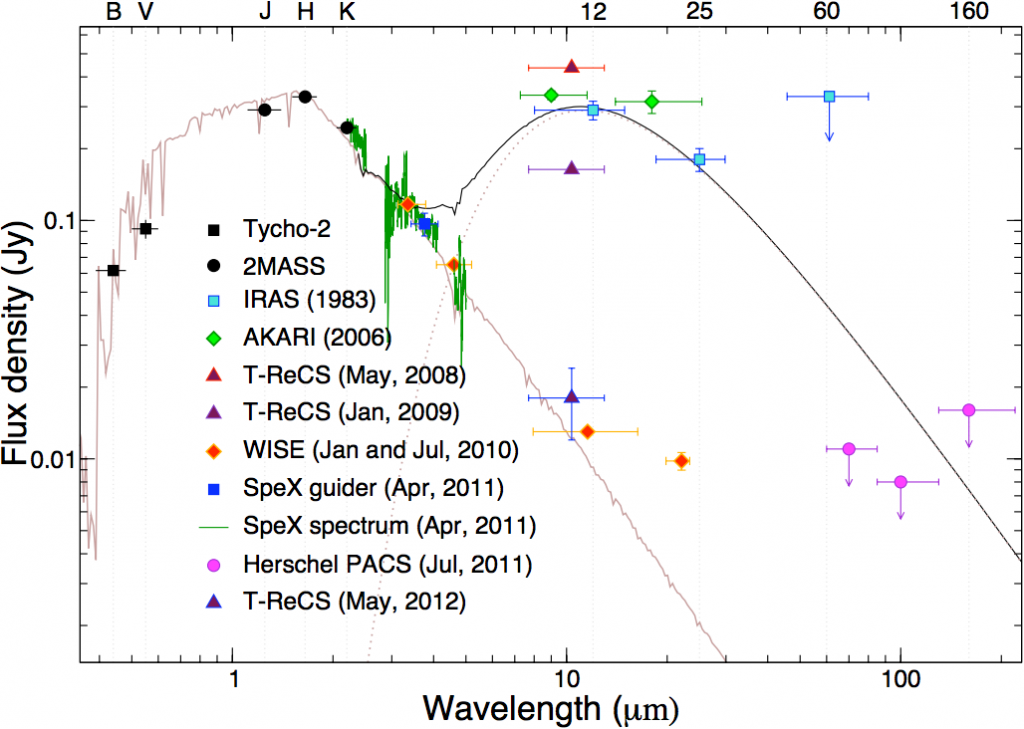TITLE: Rapid disappearance of a warm, dusty circumstellar disk
AUTHORS: Carl Melis, B. Zuckerman, Joseph H. Rhee, Inseok Song, Simon J. Murphy, Michael S. Bessell
FIRST AUTHOR’S INSTITUTION: University of California, San Diego
How do planets like our own Earth form around stars? This is still an open question in astronomy. It is believed that one of the main “signposts of planet formation” is the presence of a disk of dust and larger rocks, known as a debris disk, in orbit around a host star. However, astronomers are still in search of a theory that can accurately describe how these disks can evolve into the variety of planetary systems that have been observed.
Now, theorists must contend with yet another puzzling observation. In this paper, Melis et al. report on the discovery of a young, Sun-like star with a debris disk that has had nearly all of its dust suddenly vanish in a span of less than two years. The star, designated TYC 8241 2651 1, was first observed in 1983 by the NASA Infrared Astronomical Satellite (IRAS). It was found to be brightly glowing in the mid-infrared region of the electromagnetic spectrum (at wavelengths around 11 microns), at a level roughly 30 times what is expected from the star alone. This excess emission indicated to astronomers that the star had a disk of micron-sized dust particles that were absorbing the light from the star and re-radiating the radiation at infrared wavelengths, much like the Earth absorbs light from the Sun and re-radiates in the infrared. The dust grains radiate light with wavelengths in this region due to their temperature, which the authors estimated to be close to 350 degrees Fahrenheit.

An artist's illustration showing the TYC 8241 2652 1 system before (left) and after (right) the dust mysteriously disappeared from the system's debris disk. Credit: Gemini Observatory/AURA Artwork by Lynette Cook

The radiation spectrum from the TYC 8241 2652 1 system, showing the disappearance of the infrared emission (near 11 microns) before and after 2009. The brown curve shows the spectrum from the host star, while the black curve shows the sum of the emission from the star and pre-2009 debris disk. Fig. 1 of Melis et al. (2012)
When the system was observed again in 2008, little had changed since the initial measurement in 1983. Then, things started to get strange. The observations showed that the infrared emission from the system had reduced by a factor of more than two by mid-2009. By 2010, the infrared radiation was barely detectable, reduced by a factor of roughly 30 from the pre-2009 measurements. The debris disk that was once filled with dust glowing in the infrared was suddenly not so dusty. This unprecedented observation was confirmed recently in 2012, and the debris disk around TYC 8241 2651 1 has now been without warm dust for 2.5 years.
To add to the puzzle, the authors do not have a truly compelling explanation for the sudden disappearance of the dust. One possible mechanism involves a process where the gas in the disk exerts a drag force on the dust, causing it to rapidly accrete on to the host star. The authors also postulate that a runaway collisional process could break up the dust to extremely small pieces. These pieces could then be blown out of the system by the pressure exerted by the star’s radiation. Both of these explanations have their shortcomings, and neither of these processes has been observed in other systems to occur on timescales as short as two years.
The authors were able to determine that TYC 8241 2651 1 is a mere 10 million years old, an infant compared to our own middle-aged Sun, which is now 4.6 billion years old. As a young, Sun-like star with a (once dusty) debris disk, the system is likely in the earliest stages of planet formation, a process that could eventually result in a planetary system like the Solar System. The unpredicted dust removal from TYC 8241 2651 1’s disk offers an intriguing opportunity to gain insight into planetary formation, a process that has puzzled astronomers to date. Continued observation of the system and improved modeling in the future may help unravel the mystery of how planets like our own Earth are born.





Trackbacks/Pingbacks